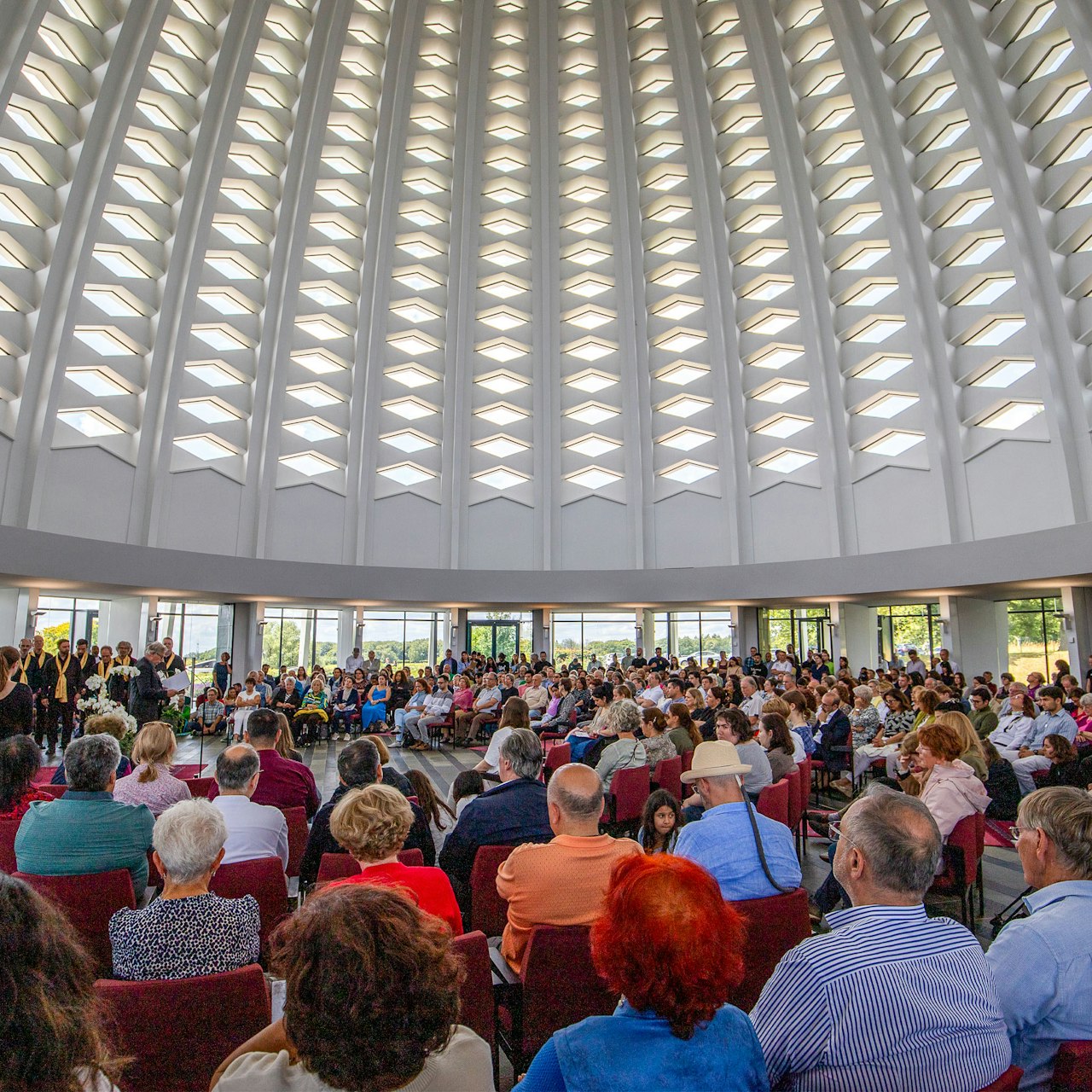
«Un refugio para todos»
El templo bahá’í de Alemania celebra su 60 aniversario
Unas cuatro mil personas de toda Europa reflexionan sobre el papel unificador del templo en los últimos sesenta años.

Unas cuatro mil personas de toda Europa reflexionan sobre el papel unificador del templo en los últimos sesenta años.
LANGENHAIN, Alemania — Visitantes de toda Europa realizaron una pausa al acercarse a la Casa de Adoración Bahá’í de Langenhain, asimilando las palabras que elevaron sus mentes y sus corazones hacia un punto de paz interior: «Esta casa es un refugio para la contemplación más profunda de la realidad espiritual y las cuestiones fundamentales de la vida». Al entrar, les envolvió una atmósfera de tranquilidad y de reverencia. La luz penetraba por los quinientos cuarenta paneles de cristal de la cúpula, iluminando el espacio interior. Fuera, en el entorno del templo, se llevó a cabo una dinámica celebración en la que la unidad y la paz fueron una experiencia tangible.
Este sagrado lugar acogió a unas cuatro mil personas durante cuatro días, entre ellas representantes del Gobierno, de la sociedad civil, personas de todas las confesiones y no creyentes así como familias y residentes de las comunidades cercanas que habían venido a celebrar el 60 aniversario del templo.
Uno de los oradores participantes del acto fue Christian Heinz, ministro de Justicia del estado de Hesse, quien compartió algunas reflexiones sobre la importancia del templo. Enfatizó que la Casa de Adoración, situada en el sosegado entorno de Hofheim-Langenhain, surgió como un símbolo de esperanza en un momento en el que más se necesitaba, tras la Segunda Guerra Mundial, cuando el continente se recuperaba de graves convulsiones y destrucción.
Heinz comentó: «El pensamiento que me viene a la mente es que la Casa de Adoración surge de la convicción de que la paz entre las personas solo puede darse en una comunidad inclusiva, en la que todos puedan participar y aportar a voluntad. Este lugar está abierto a todas las personas independientemente de su afiliación religiosa u origen, un refugio para todos». Afirmó que esta inclusividad es un poderoso contrapunto a las tendencias de exclusión que se dan en la sociedad actual.
Hans Martin Noltenius, secretario de la Asamblea Espiritual Nacional de los Bahá’ís de Alemania, afirmó que el templo es «un símbolo de la unidad de la humanidad, un principio rector de la Fe bahá’í, con sus nueve entradas orientadas en todas direcciones, que dan la bienvenida a personas de todas las procedencias y religiones».
El alcalde Christian Vogt destacó la importancia del templo como símbolo de unidad: «Este excepcional edificio constituye una parte indispensable de nuestra ciudad. Pero lo que enriquece a nuestra comunidad es, sobre todo, vuestra apertura y tolerancia hacia personas de todas las religiones y formas de ver el mundo».
A continuación, se ofrece una muestra representativa de los cuatro días del aniversario en los terrenos de la Casa de Adoración, que contó con programas de oraciones, presentaciones artísticas y una exposición sobre la historia del templo.
Los programas religiosos y los versículos cantados por el coro crearon una atmósfera espiritual inspiradora en la Casa de Adoración bahá’í.
En el interior del templo, los visitantes de múltiples procedencias hallaron un momento de serenidad para la oración y la reflexión. Jayden, de 14 años, detallaba cómo la atmósfera en el recinto de la Casa de Adoración le permitió reflexionar profundamente sobre su vida y su futuro. «Empecé a reflexionar sobre cuestiones importantes que no me había planteado anteriormente, hallando inspiración para mi futuro, un futuro en el arte».
La presencia de numerosos jóvenes contribuyó notablemente a la animada atmósfera de la celebración. Un joven, Lasse, comentó: «Siempre que vengo a la Casa de Adoración siento la unidad de la familia humana. No existe ningún sentimiento de separación por la procedencia de cada persona: se acoge a todo el mundo calurosamente y te sientes cómodo, no como un extraño. Rara vez se encuentra este hermoso sentimiento en la sociedad».
Kristina, otra joven que asistió al acto, afirmó: «Fue un honor para mí participar en las celebraciones y pasar estos días de alegría en compañía de gente maravillosa de todo el mundo. El sentimiento de compañerismo estuvo conmigo todo el fin de semana».
Con presentaciones y actividades durante los cuatro días de la celebración, los participantes conocieron los programas educativos bahá’ís que fomentan modelos de vida comunitaria basados en el servicio y la adoración. Manish Kanojiya, uno de los asistentes, declaró: «Las oraciones sinceras y las conversaciones sobre los proyectos comunitarios fueron un recordatorio de que lograr un impacto positivo empieza por reunirse en amor y amabilidad».
Layla, de Kazajistán, explicó: «Servir a los demás no solo es un acto individual sino una labor colectiva que une a las comunidades. La celebración demostró que a través de la oración y el servicio compartidos podemos desarrollar comunidades fuertes y cohesionadas, que encarnen los principios de la Fe bahá’í», como la igualdad de mujeres y hombres, la armonía entre la ciencia y la religión y la justicia.
El acto incluyó una exposición sobre la historia del templo.
Vista aérea de la Casa de Adoración bahá’í de Langenhain.